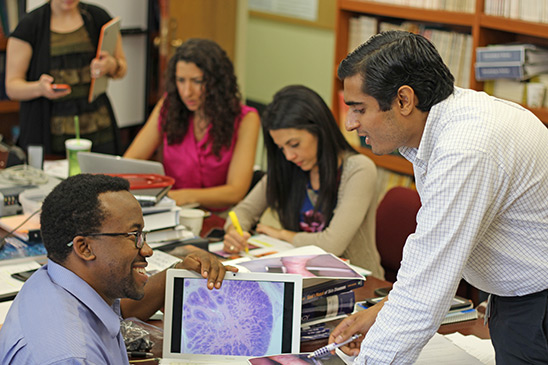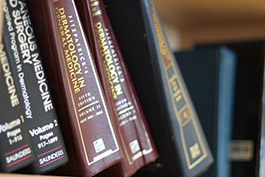Academic Day

Overview
Residents receive formal academic teaching every Wednesday during our full day of didactics. Given that we rotate at so many clinical sites, Wednesdays give us an opportunity to come together as a program. The day includes a review of several dermatopathology unknowns, faculty-led textbook review and journal club, and a resident-run kodachrome session. Additionally, various curricula for dermatologic surgery and cosmetic dermatology are covered during this protected education time. A highlight of each academic day is the visiting expert Grand Rounds lecturer. In addition, over three years of residency, each resident presents several cutting edge research topics and interesting case presentations of their own choosing for our monthly Benjamin Bender Conferences.
Typical Academic Day Schedule:
| 7 – 8am | Bolognia textbook review, with Dr. Lowenstein |
| 8 – 9am | Dermatopathology unknowns, with Dr. Heilman |
| 9 – 11am | Grand rounds, with varied highly respected academic dermatologists from around the country |
| 11am-12pm | Journal Club (JAAD, JAMA Dermatology), with Dr. Brody |
| 12-1pm | Lunch |
| 1-2pm | Hurwitz Pediatric Dermatology textbook review, lead by resident and Dr. Glick |
| 2-3pm | Kodachromes, lead by resident |
| 3-4pm | May vary: Spitz textbook review, Cosmetic teaching sessions, First year introductory lectures |
Dermatopathology
Each week, our Chairman, Dr. Ed Heilman, an expert dermatopathologist, selects five glass slides for the residents to review throughout the week. The residents work at the microscope to study the slides and develop a differential diagnosis. Dr. Heilman uses the socratic method to teach essential concepts in dermatopathology and explain the key features of each unknown diagnosis.
Journal Club

One to two hours of academic day are devoted to Journal Club, run by Dr. Neil Brody. Journal Club is designed to keep residents abreast of current knowledge in the dermatologic literature. Residents review the Journal of the American Academy of Dermatology (JAAD) as well as JAMA Dermatology.
Additionally, to make sure that residents are kept up to date on the most recent advancements in science, each journal club begins with a discussion of a basic science research article with relevance to dermatology. This article, referred to as the "outside article," is often a research paper published in The Journal of Investigative Dermatology, Nature, or Science.
Textbook Review

The Third Edition of Bolognia's Dermatology and Hurwitz's Clinical Pediatric Dermatology are the primary texts reviewed in our rigorous curriculum. Bolognia textbook review is conducted by Dr. Eve Lowenstein, an excellent educator and highly experienced clinician in complex medical dermatology. Pediatric textbook review is conducted by a senior resident in conjunction with our program director, a board-certified pediatric dermatologist, Dr. Sharon Glick. Additional textbooks used for selected chapters and textbook readings include Andrews' Clinical Dermatology, Spitz's Genodermatoses, Robinson's Surgery of the Skin, and Weedon's Skin Pathology, among others.
First year Lectures
Over the first two months of the first year, the following lectures are provided exclusively for first year resident education. The introductory lecture series helps to ease the transition into dermatology residency and focuses on high-yield topics.
Introductory lecture series for first year residents:
- Basic dermatology and morphology
- Neonatal dermatology
- Introduction to dermatopathology
- Acne and Rosacea
- Dermatologic medications and usage
- Phototherapy
- Toxic Epidermal Necrolysis and drug reactions
- Alopecia
- Dermoscopy
- Cutaneous Lupus Erythematosus
- Dermatologic emergencies
- Papulosquamous dermatoses
- Lichenoid dermatoses
- Bacterial and fungal infections
- Vasculitis
- Benign skin neoplasms
- Malignant skin neoplasms
- Laser theory
Kodachromes
Each academic day, one resident is assigned to present Kodachromes. Each presentation consists of a series of 25 kodachromes that all residents review as a group. Residents critically discuss each image and work together to enhance their visual knowledge of dermatology.